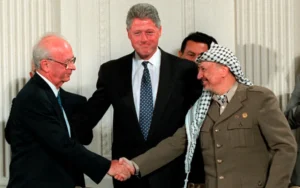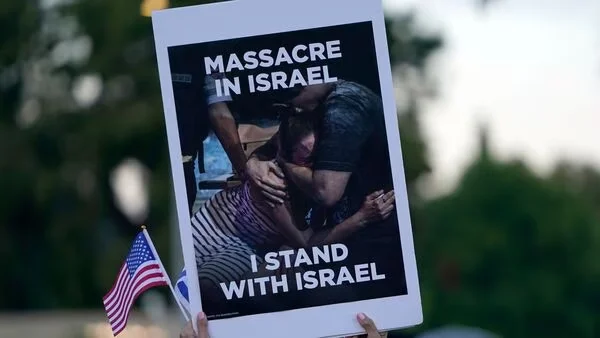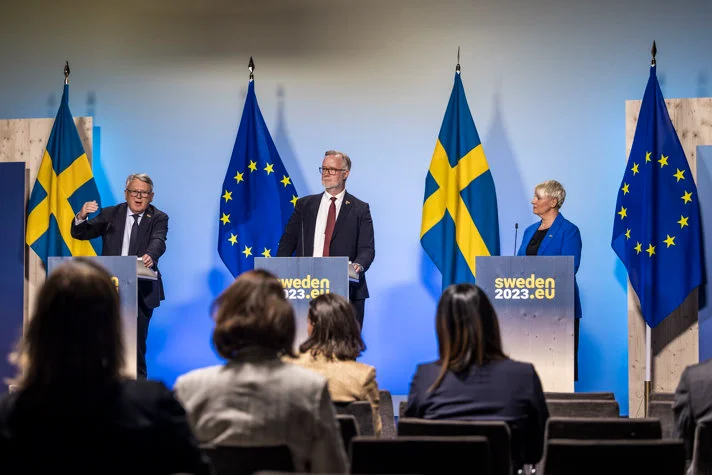What are the root causes of this conflict?
The conflict boils down to Israel’s need for security in a region it views as unfriendly, clashing with the Palestinian desire for their own state.
In 1948, Israel was officially established by David Ben-Gurion, offering a safe place for Jews escaping persecution and wanting a homeland with deep historical ties.
For Palestinians, this event is remembered as the Nakba, or catastrophe, as it led to their displacement and dashed hopes of having their own state. Around 700,000 Palestinians, representing half of the Arab population in British-ruled Palestine, were forced to leave their homes. Many ended up in Jordan, Lebanon, Syria, Gaza, the West Bank, and East Jerusalem.
Israel, a strong ally of the United States, disputes the claim that it expelled Palestinians from their homes and highlights that it was attacked by five Arab nations the day after its formation. Although fighting ceased in 1949 through armistice agreements, a formal peace was never reached.
The Palestinians who remained in the area during the war are now part of the Arab Israeli community, comprising roughly 20% of Israel’s population.
Here are the significant conflicts that have occurred since then:
In 1967, Israel launched a preemptive attack on Egypt and Syria, starting the Six-Day War. As a result, Israel gained control of the West Bank, Arab East Jerusalem (taken from Jordan), and the Golan Heights (captured from Syria), and has held onto these territories ever since.
In 1973, Egypt and Syria launched attacks on Israeli positions along the Suez Canal and the Golan Heights, sparking the Yom Kippur War. Israel managed to push both armies back within three weeks.
In 1982, Israel invaded Lebanon, leading to a 10-week siege in which thousands of Palestinian fighters under Yasser Arafat were evacuated by sea. In 2006, another conflict erupted in Lebanon when Hezbollah militants captured two Israeli soldiers, prompting Israeli retaliation.
Israel withdrew from Gaza in 2005, which it had occupied since the 1967 war with Egypt. However, Gaza has experienced significant escalations in violence in 2006, 2008, 2012, 2014, and 2021, involving Israeli airstrikes and Palestinian rocket attacks, as well as occasional cross-border incursions by both sides.
In addition to these wars, there were two Palestinian uprisings, known as intifadas, occurring from 1987 to 1993 and then again from 2000 to 2005. The second intifada included a series of Hamas suicide bombings against Israelis.
Various attempts have been made to achieve peace in the region:
In 1979, Egypt and Israel signed a peace treaty, putting an end to 30 years of conflict.
In 1993, Israeli Prime Minister Yitzhak Rabin and Arafat shook hands on the Oslo Accords, which aimed at granting limited autonomy to Palestinians.
In 1994, Israel signed a peace treaty with Jordan, further easing tensions in the area.
The Camp David summit in 2000, involving President Bill Clinton, Israeli Prime Minister Ehud Barak, and Arafat, unfortunately did not result in a final peace agreement.
In 2002, an Arab proposal offered Israel the opportunity for normal relations with all Arab nations in exchange for a complete withdrawal from the territories it had taken in the 1967 Middle East war. This plan also included the establishment of a Palestinian state and a fair solution for Palestinian refugees.
Peace efforts have hit a standstill since 2014 when negotiations between Israelis and Palestinians in Washington failed to make progress.
Subsequently, Palestinians chose to boycott dealings with the administration of U.S. President Donald Trump, as it departed from decades of U.S. policy by not endorsing the two-state solution. This solution envisions the establishment of a Palestinian state in the territory that Israel captured in 1967.
What’s the current status of peace efforts in the region?
Under the leadership of U.S. President Joe Biden, there’s a focus on achieving a comprehensive agreement in the Middle East. This agreement would involve normalizing relations between Israel and Saudi Arabia, which is the guardian of Islam’s two most sacred sites.
The recent conflict poses a diplomatic challenge not only for Riyadh but also for other Arab nations, including some Gulf Arab states neighboring Saudi Arabia. These states have previously signed peace agreements with Israel.

What are the key issues in the Israeli-Palestinian conflict?
Two-State Solution: This idea revolves around creating two separate states, one for the Palestinians in the West Bank and Gaza Strip, and one for Israel. However, it’s a contentious issue because Hamas, a Palestinian group, opposes this solution and aims for Israel’s destruction. Israel insists that a Palestinian state must be non-militarized to ensure its security.
Settlements: Many countries view the Jewish settlements constructed on land Israel took control of in 1967 as illegal. Israel disputes this and points to historical and Biblical connections to the land. The continuous expansion of these settlements is a major point of contention between Israel, Palestinians, and the global community.
Jerusalem: Palestinians want East Jerusalem, which includes holy sites for Muslims, Jews, and Christians, as the capital of their state. In contrast, Israel asserts that Jerusalem should remain its undivided and eternal capital, even though international recognition of its claim to the eastern part of the city is limited. In 2018, former U.S. President Trump recognized Jerusalem as Israel’s capital and relocated the U.S. embassy there, though the extent of its jurisdiction in the disputed city was not specified.
Refugees: Currently, around 5.6 million Palestinian refugees, primarily descendants of those who fled in 1948, live in various places, including Jordan, Lebanon, Syria, the Israeli-occupied West Bank, and Gaza. Many of them remain stateless, often residing in overcrowded camps. Palestinians have long called for the right of refugees and their descendants to return, totaling millions of people. However, Israel insists that any resettlement of Palestinian refugees should occur outside its borders.





